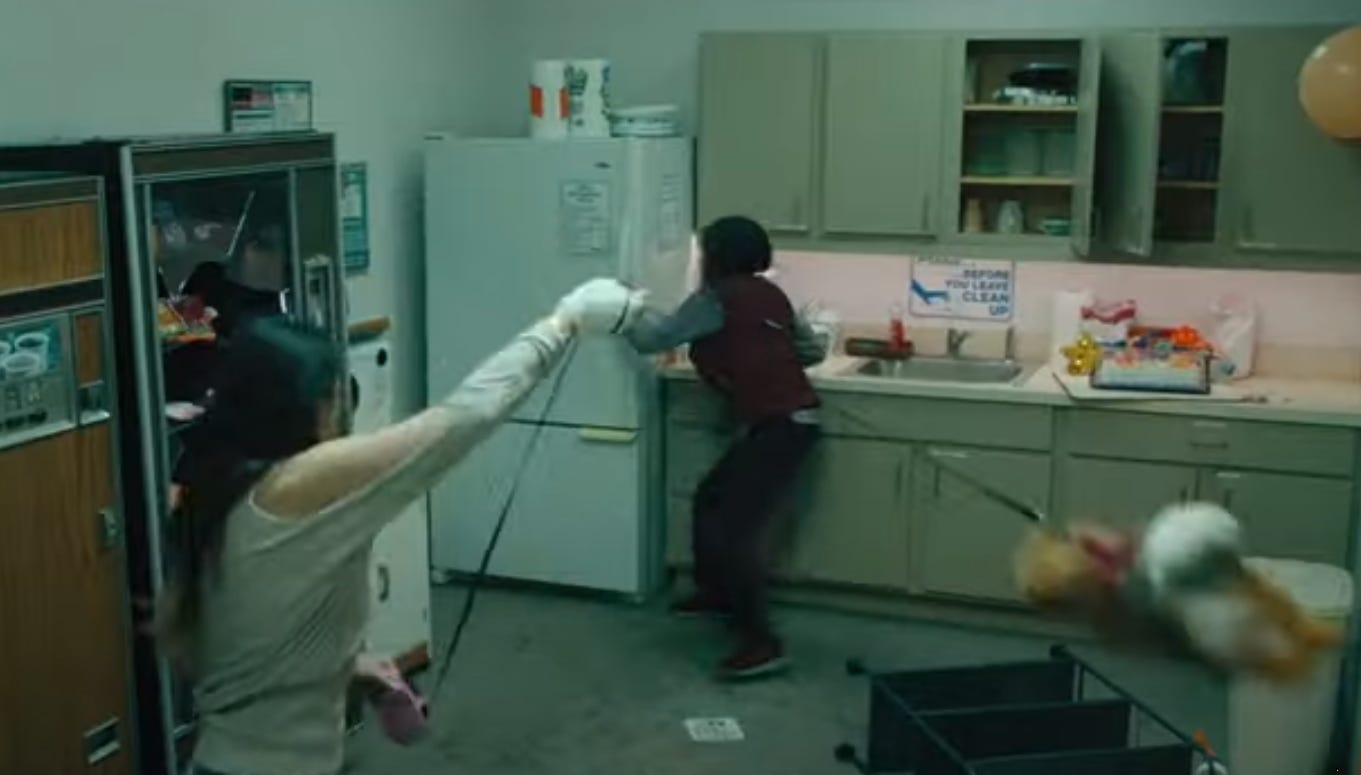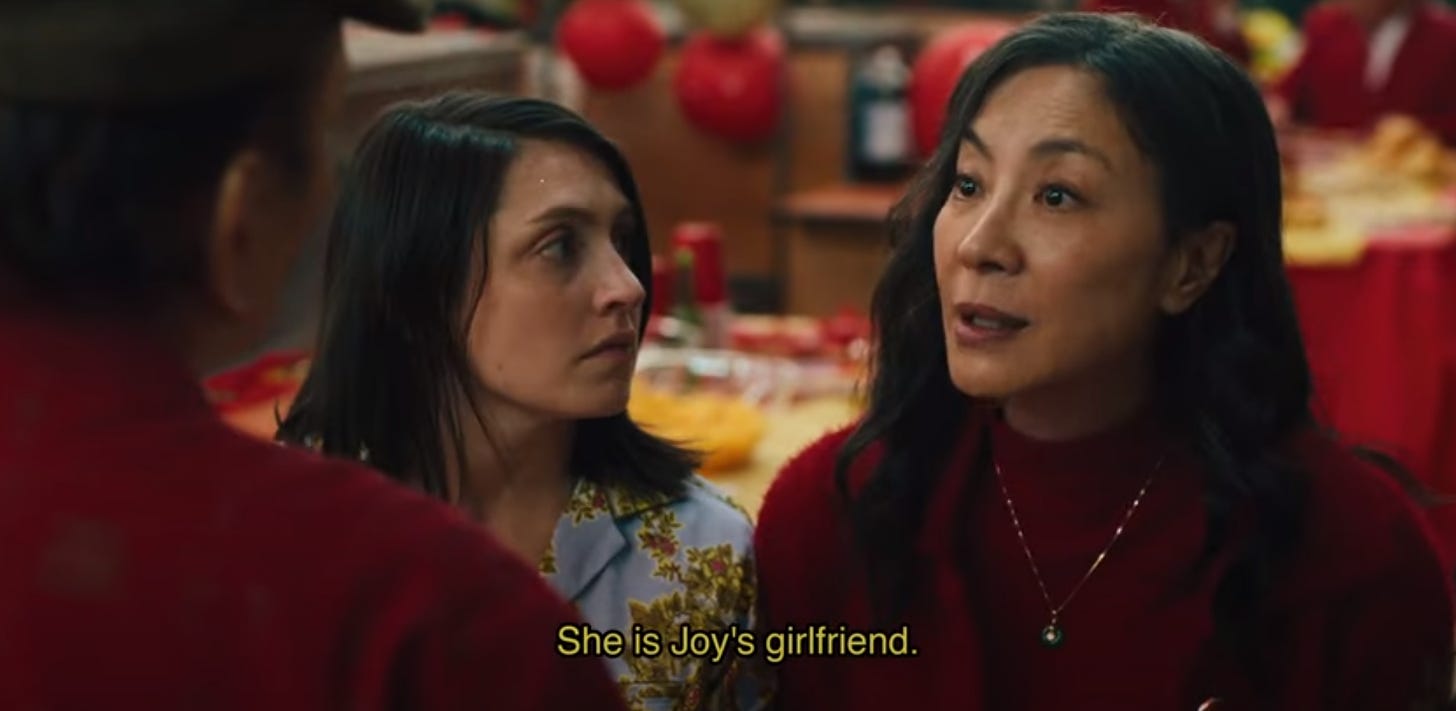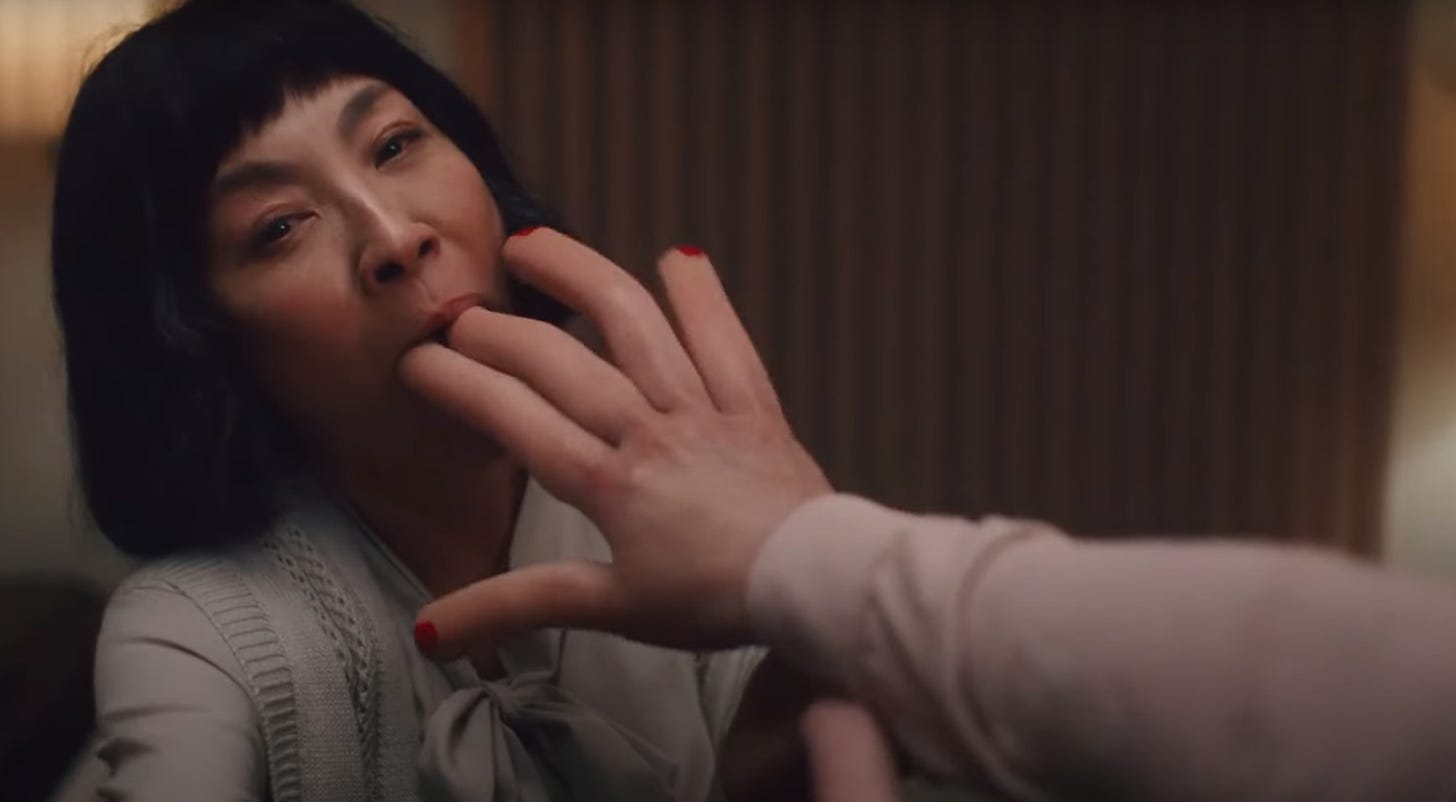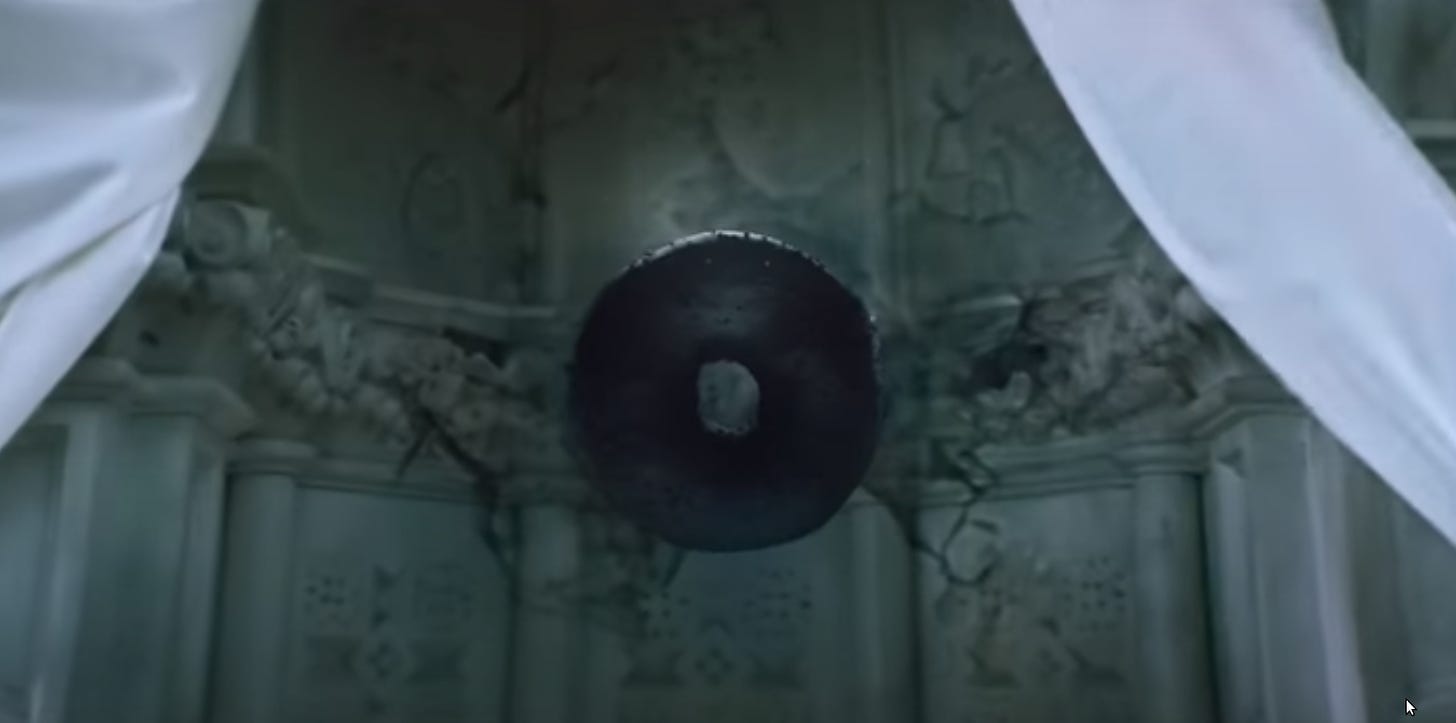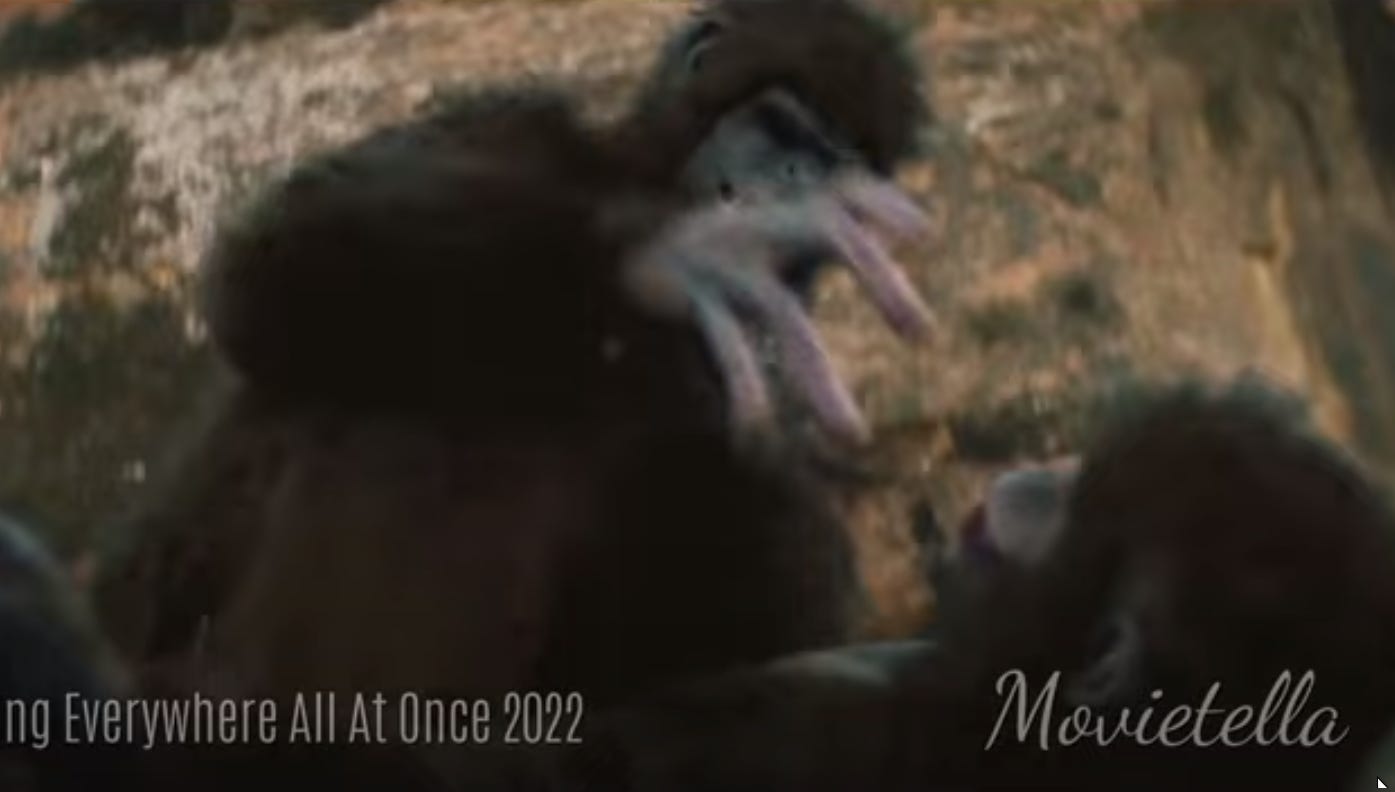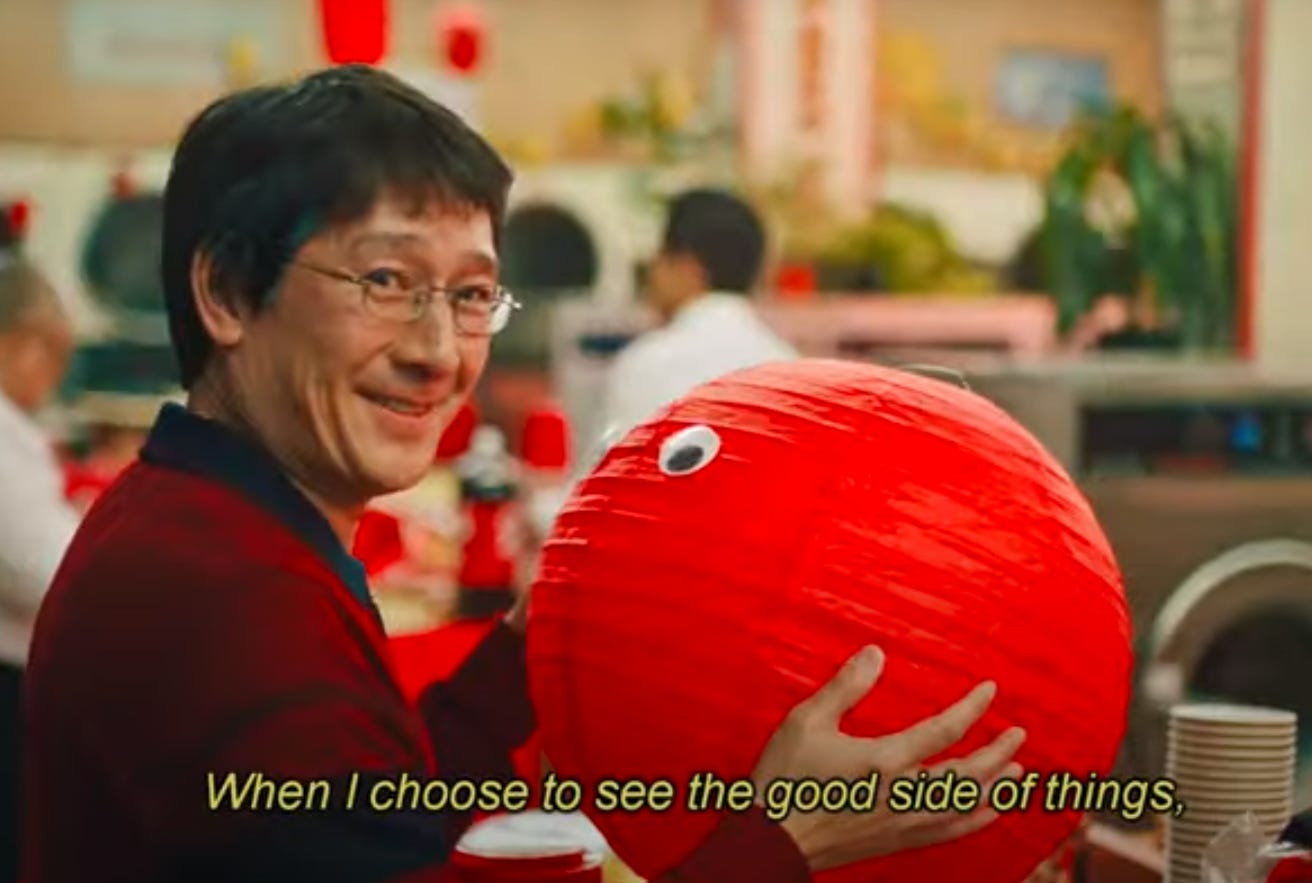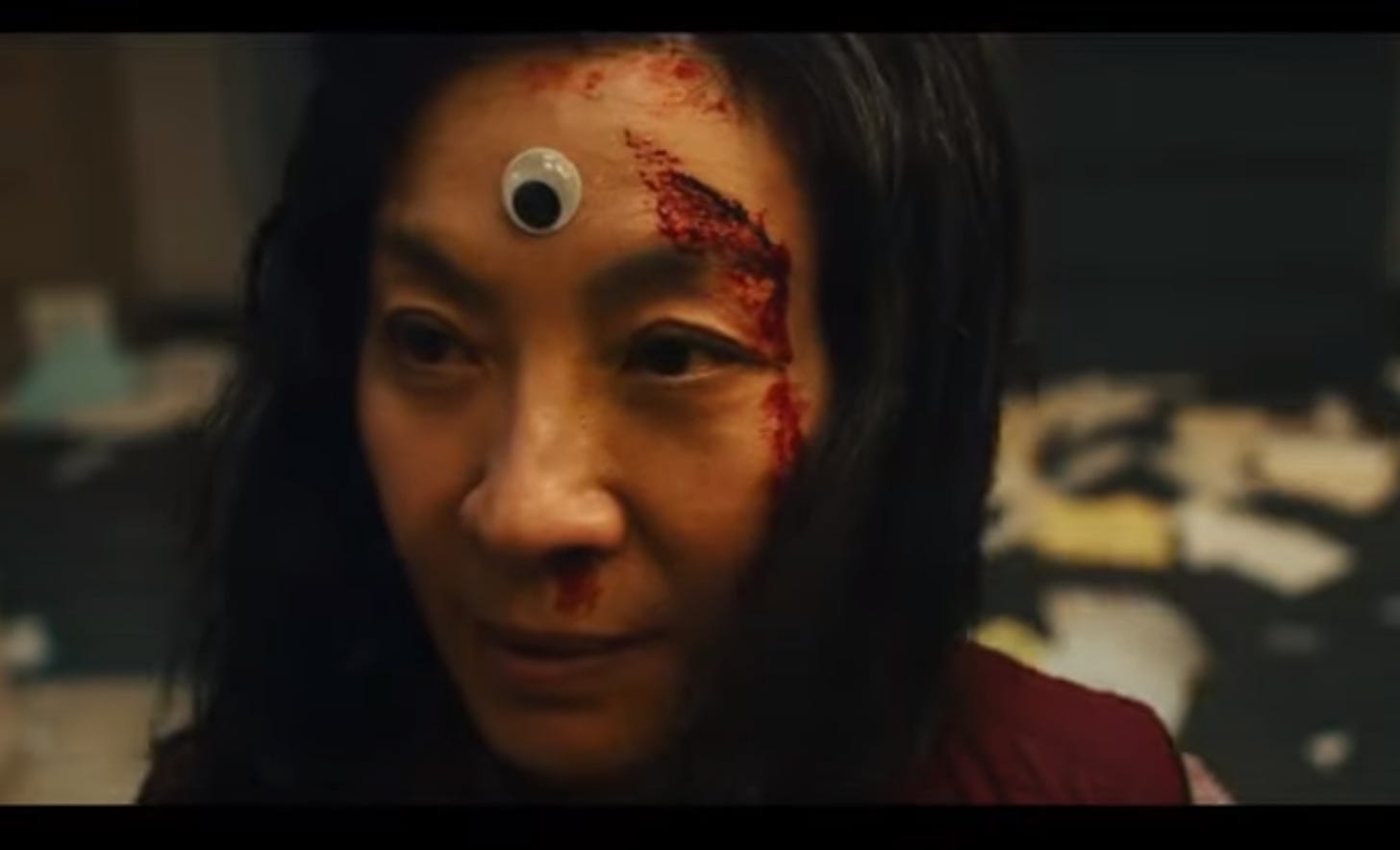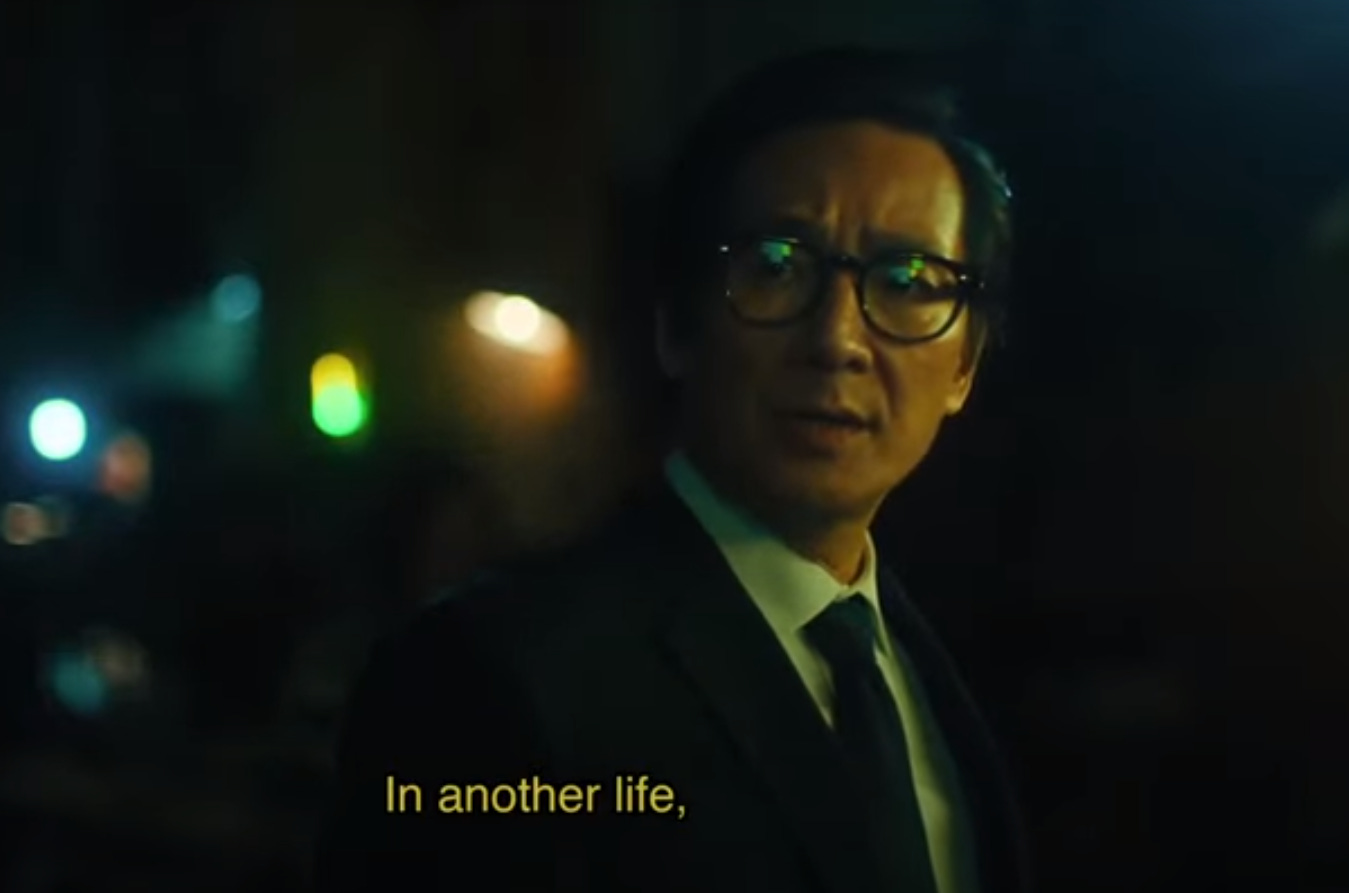In Depth Look at Everything Everywhere All At Once
What exactly is Everything Everywhere All At Once about? And what does it teach us about life, depression, and nihilism?
Art enjoys its implicity. Everything Everywhere All At Once is an artwork because it doesn’t tell you what it’s about.
The story it tells is simple: a depressed teenage universe-hopper wants to suicide, and her mother tries to talk her out of that. But this simplistic plot conceals layers of emotional and philosophical depth. Like an lenticular image, EEAAO reveals a different tale for every angle we look at it from.
That’s the beauty of this movie. Everyone can enjoy it, and for very different reasons.
The Fun
For my 6 year old brother, EEAAO is a well-executed action comedy. It has some hilarious fight sequences, and is packed with absurdly funny characters. My favorite scene is Alpha Gong Gong zooming out of the blue to save Evelyn from Jobu Tupaki in his ridiculously fast wheelchair. Oh yeah, did I mention that there is also a woman who fights by swinging her actual puppy around as a weapon.
The absurdity of EEAAO’s fight scenes evoke a nostalgic hint of Stephen Chow’s mo lei tau humor.
The Politics
Beyond comedy, Everything Everywhere All At Once is a political commentary about the difficulties Asian immigrant families face in America. And it does a fantastic job portraying immigrant families!
They captured the under-appreciated difficulty of speaking English as a second language—my parents suffer it ever day. Hack, they can’t even order at McDonald’s without getting the McDonald employee visibly irritated.
Evelyn’s FOB behavior perfectly reminds me of myself 4 years ago, when I first came to America and did ridiculous things like eating pasta with raisin… I also enjoy the mix of Mandarin with Cantonese throughout the film. As a Cantonese, I think it adequately acknowledges the complexity of Chinese culture.
To me, the most amazing part of the movie is that it doesn’t shy away from the negatives of Asian cultures. Traditional Chinese culture is conservative, stubborn, and homophobic. The movie doesn’t rose-color its ugliness. It is not afraid to “offend the Asian minority” or criticize this culture for what it is. The movie is honest with itself. Its Asians feel like real Asians, instead of a projection of what American mainstream society thinks Asians are like. That’s why this is the movie I would pick, if I needed to show one film to my non-Asian friends to help them understand what Asian culture is like.
The Philosophy
Yet, Everything Everywhere All At Once is so much deeper than that. If it were just a fun political commentary that criticizes homophobia and depicts depression, it would be a good movie, but not a great movie. A great movie doesn’t just criticize or depict a fault of society. A great story tells us something deeper, about life, about human nature, and it seeks to inspire.
At the end of the day, Everything Everywhere All At Once is about depression and existential nihilism. It reminds us of what matters in life, and teaches us a way to triumph depression and a lesson about living.
Being dwarfed
In Everything Everywhere All At Once, the multiverse is infinite. In every single one of them, there is a different Evelyn living a different life. What does it matter, then, when one copy of the Evelyns dies?
We live with a strong sense of identity—that we are unique. That we matter—to those around us and to ourselves—because there is only one us. Our uniqueness convinces us of our irreplaceability. EEAAO’s multiverse takes this belief of irreplaceability, and spits on it. Indeed, what value does the life of one particular Evelyn hold, when there are infinitely many Evelyns?
Evelyn devolves into nihilism. She feels dwarfed and is convinced that life is futile. She smashes up the windows of the laundromat she runs, and in another universe, she divorces Waymond. Why would she cherish her life if there were a million such lives sprinkled across the multiverse.
If our life is just tiny speckle in the infinity of the multiverse, there seems to be no reason to cherish it. There seems to be no reason to face our problems instead of just ignoring them—since whatever we end up doing has no bearing on the infinity of the multiverse. Our life is just “turning around in circles” in futility.
EEAAO takes us, the viewers, through the journey of existential dread as Joy and Evelyn come to realize the magnitude of the universe and the minuteness and futility of their life in comparison.
Lost in chaos
Everything Everywhere All At Once is a movie that embodies organized chaos. Crazy things happen in the movie! Evelyn and Joy turn into two fricking rocks at one point; they fight in an anime universe once; and Evelyn ends up making out with her IRS agent with hands made out of hot dogs in one scene. Nothing makes sense about half the scenes in the movie—and that’s the point.
The absurdity and senselessness of the movie embodies the senselessness of life.
“Nothing makes any sense” —Joy
Life is like that, from time to time. Evelyn gets accused of tax fraud; she faces divorce with her husband; Joy lives with homophobic parents; she is not understood and needs to constantly put up with her parents’ catechism—the point is, life dunks a cold bucket of water down our heads, for no reasons at all.
Being able to hop between universes, Joy and Evelyn witnesses the full magnitude of the butterfly effect. Every single random event in history alters our life path drastically—in one branch of the multiverse, apes with hot dog fingers killed ordinary apes millions of years ago, and because of that stupid fact, homo sapiens ended up having hot dogs as fingers.
EEAAO creates a sense that our current life and future all result from a long chain of random dice rolls. There seems to be no causal structure in our life. And our sense of self-agency is but an illusion, since our fate is eventually governed by probabilistic dice rolls.
Evelyn wants to believe that if she treats life rightly, life will treat her rightly—that she can figure out her problems through her efforts. In one scene, Evelyn’s husband Waymond convinces the IRS agent to give them another chance. This scene seems to attest to Evelyn’s conviction, and gives her a tinge of hope that she may have self-agency in this otherwise senseless world.
Joy dismisses such occasional good things in life as nothing but a “statistical inevitability”: If you roll the dice enough number of times, eventually you may get lucky and pull off something good. Life occasionally makes sense—that effort leads to reward—but in most cases, nothing happens even if you put in a lot of efforts. Even if we work hard to improve our relationships, and better our life, sometimes a statistical coin flip decides to dunk a cold bucket of water down our head. Life happens. It’s senseless and doesn’t care about our efforts. Life is a torturous game.
Why live when life doesn’t matter and is so torturous
The whole movie sets up this central question about life: the daughter Joy wants to suicide because she is tired of the senseless chaos of life and finds life futile; the mother Evelyn tries to stop her.
I think EEAAO does a fantastic job identifying some reasons why teenagers suffer from depression and existential crisis—the nihilistic view of life as futile, and the loss of self-agency due to the chaos of life. Its response to existential nihilism is absurdism. And it is able to impart these philosophical ideas through a masterful manipulation of the audience’s emotion.
Again, I think that’s the greatest thing about Everything Everywhere All At Once—everyone can enjoy it. Even if someone does not recognize the philosophical argument it tries to make, they can still find it emotionally convincing.
Absurdism
Hollywood movies love to feature a hopeless romantic hero. Waymond is EEAAO’s hopeless romantic hero. He is forever kind and loving. Even though he understands that life is minute and futile, he does not respond by treating those around him with callousness. He does not ignore life’s problems just because “life, at the end of the day, doesn’t matter.” He treats everyone with kindness and love. He lives life to the fullest. He humors its absurdity and senselessness—in the movie, he is the one who puts googly eye stickers everywhere to lighten up the mood of his family.
Waymond inspires Evelyn through a journey to embrace the absurd. She learns to face the disempowerment of her self-agency through humor and acceptance—instead of grieving that a bucket of cold water is randomly dunked over her head, she accepts laughs it off and enjoys a cold bath. Instead of treating her own life and others in her life with coldness, she treats them with love.
Instead of answering the question “why live when you don’t have to,” Waymond’s absurdist optimism flips the question around and asks “why die when you can live.”
A lot of people seems to be confused by the plot of Everything Everywhere All At Once. Well, the plot doesn’t make sense, because it’s not supposed to be. The absurdity of Evelyn riding on a guy’s hat like Ratatouille is intended. It is a symbolism of the absurdist theme of the movie—that the world is senseless, and the best we can do is to humor ourselves and enjoy the senseless absurdity.
Be present to find pleasure in life’s simple things
I think this is my favorite life lesson from Everything Everywhere All At Once. I personally don’t find the absurdist argument particularly compelling. I had existential crisis before. And being an optimist or an absurdist isn’t really enough to fill the emotional hole that comes from the emptiness of life.
This second piece of advice feels more compelling to me. When life seems empty or full of senseless struggles, slow down, be present, and enjoy the simple things in life.
An example EEAAO gives is—as every Hollywood movie—love. The movie handles Evelyn’s romance with Waymond expertly, and presents “love” as a beautiful thing the stay alive for, in a very emotionally compelling manner.
In one emotional climax, Evelyn questions a Waymond in another universe why he wouldn’t give us on her. This Waymond didn’t marry Evelyn and accrued tremendous wealth. He simply replies—and I am never getting this out of my head—“in another life, I would really like just doing laundry and taxes with you.”
What is unsaid here is that Waymond would choose love in a messy life over his wealth. He would choose an ordinary family life over any personal adventures or success.
And I think it really strikes home the more general point that: sometimes the things we are looking for, that we want the most—happiness, fulfillment—are right there within the ignored details of our life. We try to exercise our self-agency to get our happiness or fulfillment, and get frustrated by random obstacles life throws at us. EEAAO tries to tell us that what we are looking might be right there, beneath our nose. We just failed to be present, and notice it.
At the end of the movie, Evelyn and Joy settle back into ordinary life. Evelyn is temporarily distracted by other universes, but pulls her attention back to her own universe. She is present, and mature. She knows what lies outside in the multiverse, but she also knows what she wants is right there inside her universe.


